Francis of Assisi

Saint Francis of Assisi (September 26, 1181 – October 3, 1226) is a Christian Saint. He is the founder of the Franciscan Order and patron saint of animals, the environment, merchants, Italy and Catholic Action. He was born in Assisi, Italy, where a large basilica was built in his honor.
On his feast day, October 4, many churches have a ceremony for people to bring their pets and working animals to church. It is also on this date that World Animals Day is celebrated.
Early life
Saint Francis was born to Pietro Bernardone, a wealthy cloth merchant, and his wife Pica. He was originally named Giovanni Francesco Bernardone.[1][2] In his youth, he was first interested by French troubadours, known as wanderers who improvised songs on a stringed instrument. He later planned a career in military. When he was serving in the war between Assisi and Perugia in 1202, at the battle of Ponte Saint Giovanni,[3] he was captured and imprisoned for a year and became extremely ill.[4]
When Francis returned to Assisi he had a religious conversion experience, including a reported message from Christ calling him to leave this worldly life. He began taking his Christianity faith seriously. He acted towards people as if the Gospels were his law, taking Jesus Christ as a literal example for loving one another. He dressed in rough clothes, ask and begged for his sustenance, and preached purity and peace. His family disapproved, and his father disinherited him, so Francis renounced his wealth and inheritance. After that Francis started visiting hospitals and caring for the sick including of leprosy.
In 1209 Francis started to attract followers, and with a blessing from the pope, he founded the Franciscans based on a simple statement by Jesus: “Leave all and follow me”. In 1219, he went to Egypt to convert the Sultan so that the conflict of the Crusades could end.
Legend
Legend has it that, according to the Little Flowers of St. Francis, Francis saved Gubbio, a village in Italy, from a hungry and massive wolf. The wolf was terrorizing the village, but over a few nights, Francis convinced the wolf to stop, and in exchange, the villagers agreed to feed the wolf.
Francis Of Assisi Media
The oldest surviving depiction of Saint Francis is a fresco near the entrance of the Benedictine abbey of Subiaco, painted between March 1228 and March 1229. He is depicted without the stigmata, but the image is a religious image and not a portrait.[5]
Pope Innocent III approving the statutes of the Order of the Franciscans, by Giotto
St. Francis preaching to the birds outside of Bevagna (by Master of St. Francis).
Francis considered his stigmata part of the Imitation of Christ. by Cigoli, 1699
St. Francis talking to the wolf of Gubbio (Carl Weidemeyer, 1911)
Corpus Christi carpet in São Manuel, São Paulo, Brazil, 2025.
Francis' last resting place at Assisi
References
- ↑ "Francis of Assisi, St." Environmental Encyclopedia. Gale, 2009. Biography In Context. Web. 27 Feb. 2013.
- ↑ "Francis of Assisi." Historic World Leaders. Gale, 1995. Biography In Context. Web. 27 Feb. 2013.
- ↑ "Francis of Assisi." Historic World Leaders. Gale, 1994. Biography In Context. Web. 27 Feb. 2013.
- ↑ "Francis of Assisi, St." Environmental Encyclopedia. Gale, 2009. Biography In Context. Web. 27 Feb. 2013.
- ↑ Brooke 2006, pp. 161–162.








